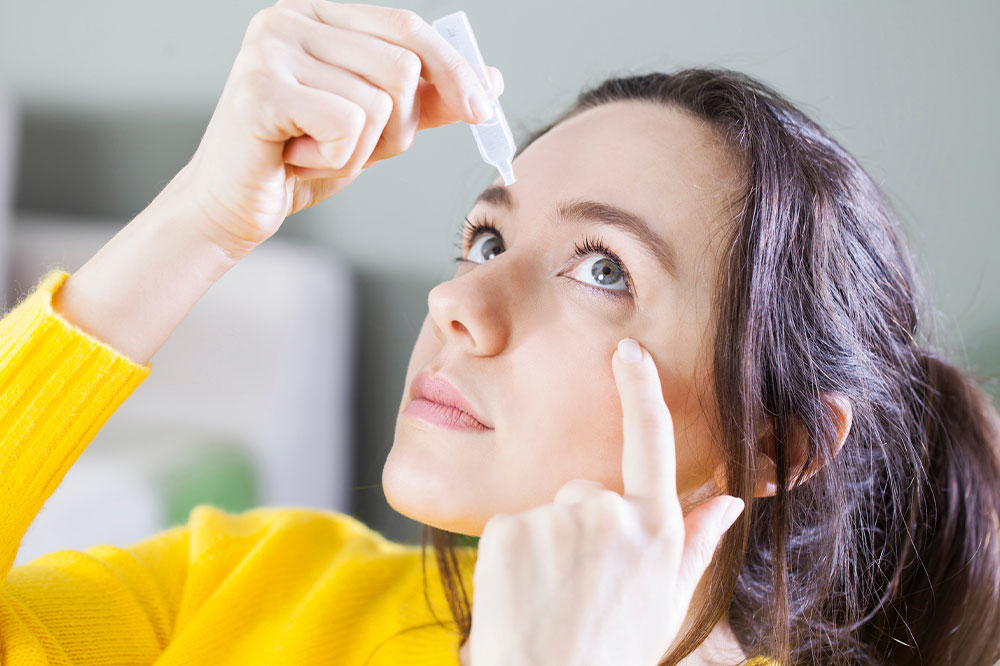Eye Allergies – Symptoms, Causes, and Relief Methods
When the eyes react to allergens and the immune system responds, it can lead to allergic conjunctivitis, another name for eye allergies, resulting in eye inflammation and pain. Other allergens like cosmetics or eye drops can also bring on this condition. It is frequently brought on by airborne allergens such as pollen, dust mites, pet dander, and mold spores. People of all ages might develop itchy eye allergies. Here’s more about its symptoms, causes, and remedies.
Common symptoms of eye allergies: What to look for?
Discomfort and irritation are the most common symptoms of eye allergies, though they might vary from person to person.

- Redness in eyes
- Watery eyes
- Swelling of eyelids
- Stinging or burning
- Responsiveness to light
- Distorted vision
- Congestion
- Grit or sand in the eye
If you have eye allergies, speaking with a healthcare professional for a precise diagnosis is ideal because other eye diseases could also bring on similar symptoms. The proper treatment for easing discomfort brought on by eye allergies can be determined with an appropriate diagnosis of the symptoms.
Understanding eye allergies – Causes and triggers
The immune system overreacts to allergens that come into contact with the eyes, leading to eye allergic reactions.
- Pollen: Pollen from trees, grass, and weeds is a frequent airborne allergen that can cause eye allergies.
- Dust mites: The allergenic proteins produced by these minute insects, which are present in home dust, bedding, and upholstery, can cause itchy eye allergies.
- Pet dander: People who are allergic to it may get eye allergies due to pet dander, which is made up of minute flakes of animal skin, saliva, and urine.
- Mold spores: Mold spores can become airborne and cause eye allergies when respired.
- Cosmetics and eye drops : Some people may experience allergic reactions to specific components in cosmetics, eye drops, and other eye care items, which can result in eye allergies.
- Smoke and air pollution : Some people’s eyes can become irritated and develop allergies due to exposure to smoke, such as cigarette smoke and air pollution.
- Irritants: For some people, exposure to irritants like dust, chemicals, or strong scents can lead to eye allergies.
- Contact lenses: Some people may experience eye irritation and allergies due to wearing contact lenses, particularly extended-wear lenses or lenses that have not been well-cleansed and disinfected.
- Weather variations: Weather variations like windy or dry conditions, which increase the number of allergens in the air, can induce eye allergies by drying out the eyes and making them susceptible to irritation.
The frequency and severity of eye allergies can be decreased by avoiding or limiting exposure to allergens, taking over-the-counter or prescription treatments as directed by a healthcare professional, and maintaining proper eye hygiene.
Allergic reaction around the eyes
Pollen, pet dander, dust mites, cosmetics, eye drops, and other irritants that set off an immunological reaction are some allergens that contribute to this. Common allergic reactions around the eyes include:
- Allergic dermatitis: Skin around the eyes may become red, itchy, and swollen due to allergic dermatitis. It might also cause the skin to become dry, flaking, or scaly.
- Allergic conjunctivitis: The conjunctiva, a thin layer of tissue that covers the white of the eye and the inside of the eyelids, becomes inflamed when someone has allergic conjunctivitis. In addition to puffy and watery eyes, it can result in conjunctival edema, tears, redness, and irritation.
- Touch dermatitis: This condition develops when an allergen, such as cosmetics, eye drops, or other irritants, comes into direct touch with the skin around the eyes. At the point of contact, it may produce swelling, itching, and redness.
- Angioedema : An allergic reaction can cause angioedema, a severe form of swelling that can develop around the eyes, where the deeper skin layers get enlarged. As a result, they produce swollen eyes from allergies.
- Periorbital eczema : It affects the skin around the eyes, producing dryness, itching, and redness. Allergens or other irritants may cause it.
Avoid the trigger if you think you might have an allergic reaction around your eyes, and consult a healthcare professional for a proper diagnosis and course of therapy.
Eye allergy relief
The level of symptom severity and the underlying cause will determine the best eye allergy relief. Here are a few:
- Prescription eye drops: Your doctor may prescribe eye drops to reduce inflammation and relieve symptoms.
- Cold compresses: Placing a cold compress over closed eyes will help soothe irritation and redness while reducing swelling.
- Avoidance of triggers: One of the most effective ways to stop symptoms from happening is to recognize and stay away from the allergens or triggers that cause eye allergies, such as pollen, dust, pet dander, or cosmetics.
- Good eye hygiene: Maintaining proper eye hygiene, which includes washing hands often, refraining from rubbing or touching the eyes, and using clean towels and pillowcases, can help prevent exposure to allergens and lessen the symptoms of eye allergies.
- Oral prescription treatments: Oral prescription treatments might lessen allergy-related symptoms, including those that impact the eyes.
Bottomline
For many people, eye allergies can be irritating and lower their quality of life. However, treating eye allergies and obtaining clearer, happier eyes is possible with a comprehensive awareness of its causes and symptoms and appropriate management measures. By taking the proper steps, you can reduce how much eye allergies affect your daily life and benefit from better, more comfortable vision.

